以STO细胞和hELF作为胚胎生殖细胞培养饲养层的比较
【人教版】初中生物第二单元《生物体的结构层次》期末考知识点

【人教版】初中生物第二单元《生物体的结构层次》期末考知识点一、选择题1.科学家利用胚胎干细胞成功培育出了心肌细胞。
依据的原理主要是下图中的哪个过程A.①B.②C.③D.④【答案】D【解析】【分析】细胞分化是指细胞在生长过程中细胞的形态、结构和功能发生变化的过程,细胞分化形成了不同的组织,如动物的肌肉组织、上皮组织、神经组织和结缔组织,植物的保护组织、营养组织、分生组织和输导组织。
【详解】图示中①、②、③表示细胞分裂,细胞分裂使细胞数目增加。
细胞分化是指细胞在生长过程中细胞的形态、结构和功能发生变化的过程,细胞分化形成了不同的组织。
因此,利用胚胎干细胞培育心肌细胞的原理是④细胞分化,细胞分化的结果是形成了不同的组织。
故选D。
【点睛】解答此类题目的关键是理解掌握细胞分裂、细胞分化的过程和特点。
2.下列属于器官的是( )A.番茄果肉B.洋葱鳞片叶C.血液D.口腔上皮【答案】B【解析】【分析】除病毒以外,细胞是生物体结构和功能的基本单位。
组织是细胞分化的结果,细胞分化产生了不同的细胞群,每个细胞群由形态相似,结构、功能相同的细胞联合在一起形成的,这样的细胞群叫组织。
器官是由不同的组织按照一定的次序结合在一起构成的。
系统是由能够共同完成一种或几种生理功能的多个器官按照一定的次序组合在一起构成的。
【详解】A.番茄果肉属于营养组织,具有营养的作用,故A错误。
B.洋葱鳞片叶属于器官,是由不同的组织按照一定的次序联合起来形成具有一定功能的结构,故B正确。
C.血液属于结缔组织,由血浆和血细胞组成,故C错误。
D.口腔上皮属于保护组织,故D错误。
故选B。
【点睛】本题考查器官的概念,解题的关键是理解器官的概念。
3.制作临时装片时必须让盖玻片的一边先接触水滴,然后缓缓放下,其目的是()A.防止水溢出来污染装片B.避免实验材料移动C.避免盖玻片下面出现气泡D.增强透明度【答案】C【解析】【分析】在制作临时装片在盖盖玻片这一步很重要,要不然容易产生气泡,气泡与细胞重叠不易观察。
【人教版】八年级生物第七单元《生物圈中生命的延续和发展》知识点
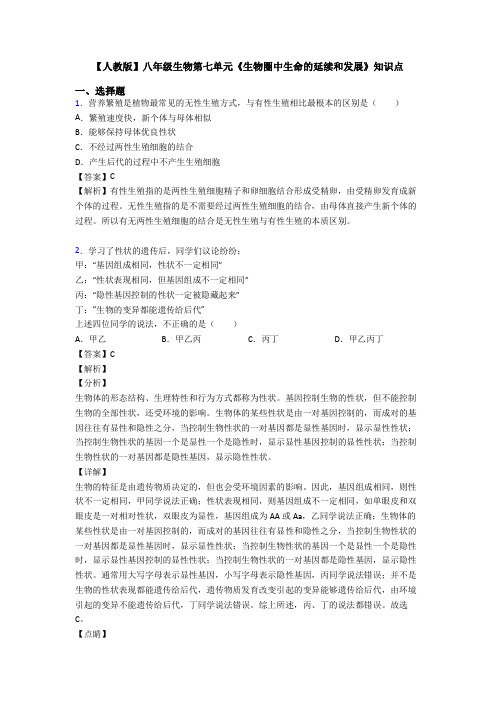
【人教版】八年级生物第七单元《生物圈中生命的延续和发展》知识点一、选择题1.营养繁殖是植物最常见的无性生殖方式,与有性生殖相比最根本的区别是()A.繁殖速度快,新个体与母体相似B.能够保持母体优良性状C.不经过两性生殖细胞的结合D.产生后代的过程中不产生生殖细胞【答案】C【解析】有性生殖指的是两性生殖细胞精子和卵细胞结合形成受精卵,由受精卵发育成新个体的过程。
无性生殖指的是不需要经过两性生殖细胞的结合,由母体直接产生新个体的过程。
所以有无两性生殖细胞的结合是无性生殖与有性生殖的本质区别。
2.学习了性状的遗传后,同学们议论纷纷:甲:“基因组成相同,性状不一定相同”乙:“性状表现相同,但基因组成不一定相同”丙:“隐性基因控制的性状一定被隐藏起来”丁:“生物的变异都能遗传给后代”上述四位同学的说法,不正确的是()A.甲乙B.甲乙丙C.丙丁D.甲乙丙丁【答案】C【解析】【分析】生物体的形态结构、生理特性和行为方式都称为性状。
基因控制生物的性状,但不能控制生物的全部性状,还受环境的影响。
生物体的某些性状是由一对基因控制的,而成对的基因往往有显性和隐性之分,当控制生物性状的一对基因都是显性基因时,显示显性性状;当控制生物性状的基因一个是显性一个是隐性时,显示显性基因控制的显性性状;当控制生物性状的一对基因都是隐性基因,显示隐性性状。
【详解】生物的特征是由遗传物质决定的,但也会受环境因素的影响。
因此,基因组成相同,则性状不一定相同,甲同学说法正确;性状表现相同,则基因组成不一定相同,如单眼皮和双眼皮是一对相对性状,双眼皮为显性,基因组成为AA或Aa,乙同学说法正确;生物体的某些性状是由一对基因控制的,而成对的基因往往有显性和隐性之分,当控制生物性状的一对基因都是显性基因时,显示显性性状;当控制生物性状的基因一个是显性一个是隐性时,显示显性基因控制的显性性状;当控制生物性状的一对基因都是隐性基因,显示隐性性状。
2017年高考生物分类试题及答案汇编知识点19 现代生物科技专题

温馨提示:此题库为Word版,请按住Ctrl,滑动鼠标滚轴,调节合适的观看比例,关闭Word文档返回原板块。
知识点19 现代生物科技专题1.(2017·江苏高考·T11)牛雄性胚胎中存在特异性H-Y抗原,可在牛早期胚胎培养液中添加H-Y单克隆抗体,筛选胚胎进行移植,以利用乳腺生物反应器进行生物制药。
下列相关叙述正确的是( )A.H-Y单克隆抗体由骨髓瘤细胞分泌B.应选用原肠胚做雌雄鉴别C.鉴别后的雄性胚胎可直接做胚胎移植D.用H-Y抗原免疫母牛可获得相应抗体【解析】选D。
H-Y单克隆抗体一般是用骨髓瘤细胞和B淋巴细胞相融合形成的杂交瘤细胞来制备,A项错误;早期胚胎细胞分化程度低、全能性高,应选用囊胚的滋养层做雌雄鉴别,B项错误;进行胚胎移植应选用雌性胚胎,C项错误;用H-Y抗原免疫母牛,该母牛可以产生相应的抗体抵御H-Y抗原,D项正确。
2. (2017·江苏高考·T14)下列关于小鼠体外受精及胚胎发育的叙述,错误的是( )A.精子在获能液中于37℃、5% CO2条件下培养的目的是使精子获能B.小鼠在特定光控周期条件下饲养,注射相关激素有促进超数排卵的作用C.分割的胚胎细胞有相同的遗传物质,因此发育成的个体没有形态学差异D.注射到囊胚腔中的胚胎干细胞可以参与个体器官的发育【解析】选C。
在37℃、5% CO2条件下,精子在获能液中培养是为了使精子获能,获能后的精子才有受精能力,A项正确;小鼠在特定光控周期条件下饲养,并注射促性腺激素,可以促进排卵(或超数排卵),B项正确;分割的胚胎细胞有相同的遗传物质,但是遗传物质在发育过程中可能有差异性的表达,所以发育成的个体可能有形态学差异,C项错误;注射到囊胚腔中的胚胎干细胞因为具有发育的全能性,且有滋养层为其提供营养,可以参与个体器官的发育,D项正确。
3. (2017·北京高考·T5)为了增加菊花花色类型,研究者从其他植物中克隆出花色基因C(图1),拟将其与质粒(图2)重组,再借助农杆菌导入菊花中。
浙江高三高中生物月考试卷带答案解析
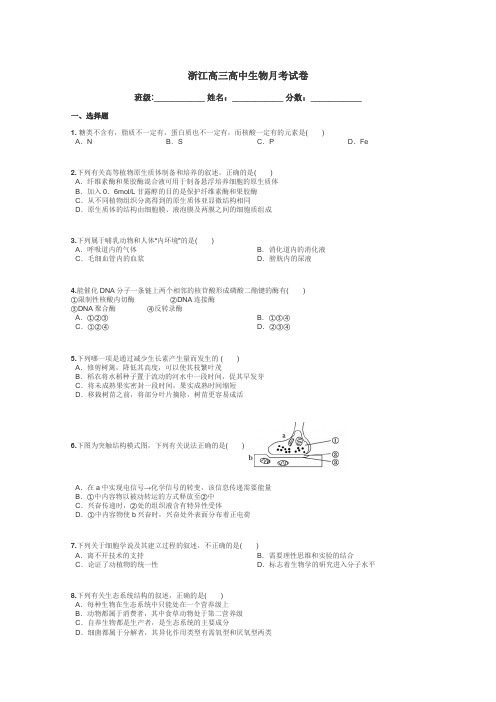
浙江高三高中生物月考试卷班级:___________ 姓名:___________ 分数:___________一、选择题1.糖类不含有,脂质不一定有,蛋白质也不一定有,而核酸一定有的元素是()A.N B.S C.P D.Fe2.下列有关高等植物原生质体制备和培养的叙述,正确的是()A.纤维素酶和果胶酶混合液可用于制备悬浮培养细胞的原生质体B.加入0.6mol/L甘露醇的目的是保护纤维素酶和果胶酶C.从不同植物组织分离得到的原生质体亚显微结构相同D.原生质体的结构由细胞膜、液泡膜及两膜之间的细胞质组成3.下列属于哺乳动物和人体“内环境”的是()A.呼吸道内的气体B.消化道内的消化液C.毛细血管内的血浆D.膀胱内的尿液4.能催化DNA分子一条链上两个相邻的核苷酸形成磷酸二酯键的酶有()①限制性核酸内切酶②DNA连接酶③DNA聚合酶④反转录酶A.①②③B.①③④C.①②④D.②③④5.下列哪一项是通过减少生长素产生量而发生的 ()A.修剪树篱,降低其高度,可以使其枝繁叶茂B.稻农将水稻种子置于流动的河水中一段时间,促其早发芽C.将未成熟果实密封一段时间,果实成熟时间缩短D.移栽树苗之前,将部分叶片摘除,树苗更容易成活6.下图为突触结构模式图,下列有关说法正确的是()A.在a中实现电信号→化学信号的转变,该信息传递需要能量B.①中内容物以被动转运的方式释放至②中C.兴奋传递时,②处的组织液含有特异性受体D.①中内容物使b兴奋时,兴奋处外表面分布着正电荷7.下列关于细胞学说及其建立过程的叙述,不正确的是()A.离不开技术的支持B.需要理性思维和实验的结合C.论证了动植物的统一性D.标志着生物学的研究进入分子水平8.下列有关生态系统结构的叙述,正确的是()A.每种生物在生态系统中只能处在一个营养级上B.动物都属于消费者,其中食草动物处于第二营养级C.自养生物都是生产者,是生态系统的主要成分D.细菌都属于分解者,其异化作用类型有需氧型和厌氧型两类9.通过以下方法所获得的免疫能力在体内保持较长时间的是()A.成人注射丙种球蛋白(抗体)B.注射乙肝疫苗C.婴儿通过母乳获得某些抗体D.注射淋巴因子10.某些类型的染色体结构和数目的变异,可通过对细胞有丝分裂中期或减数第一次分裂时期的观察来识别。
(通用版)高二生物 专题05 胚胎工程暑假作业(含解析)-人教版高二全册生物试题
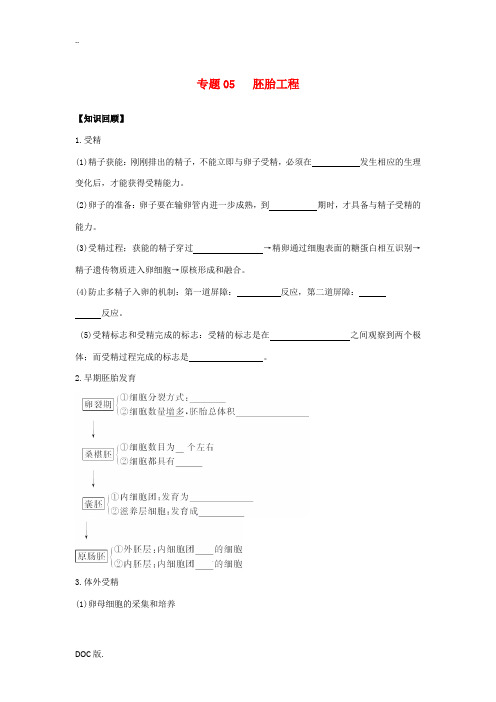
专题05 胚胎工程【知识回顾】1.受精(1)精子获能:刚刚排出的精子,不能立即与卵子受精,必须在发生相应的生理变化后,才能获得受精能力。
(2)卵子的准备:卵子要在输卵管内进一步成熟,到期时,才具备与精子受精的能力。
(3)受精过程;获能的精子穿过→精卵通过细胞表面的糖蛋白相互识别→精子遗传物质进入卵细胞→原核形成和融合。
(4)防止多精子入卵的机制:第一道屏障:反应,第二道屏障:反应。
(5)受精标志和受精完成的标志:受精的标志是在之间观察到两个极体;而受精过程完成的标志是。
2.早期胚胎发育3.体外受精(1)卵母细胞的采集和培养(2)精子的采集和获能(3)受精:和培养成熟的卵子在或专用的受精溶液中完成受精作用。
4.胚胎的早期培养(1)目的:检查受精状况和受精卵的发育能力。
(3)胚胎处理:向或冷冻保存。
5.胚胎移植(1)地位:胚胎工程其他技术的最后一道工序。
(2)过程:(3)意义:充分发挥。
6.胚胎分割(1)材料:发育良好,形态正常的。
(2)实质:胚胎分割可增加动物后代,其实质是。
(3)分割要求:对囊胚分割时,注意将均等分割,否则会影响分割后胚胎的恢复和进一步发育。
7.胚胎干细胞(1) 。
【想一想】例1.关于受精过程的叙述错误的是A.获能后的精子与卵子相遇后,释放顶体酶穿过透明带进入放射冠B.透明带反应是防止多精入卵的第一道屏障C.精子与卵黄膜相互融合,精子入卵D.雄原核形成的同时,卵子完成减数第二次分裂例2.治疗性克隆有望最终解决供体器官的短缺和器官移植出现的排异反应等问题。
下图表示治疗性克隆的过程,下列有关叙述不正确的是A.上述过程利用了动物细胞核移植、动物细胞培养等技术B.上述过程充分说明动物细胞具有全能性C.①过程的完成离不开胚胎干细胞的增殖和分化潜能D.①②过程都发生DNA的复制和蛋白质的合成例3.让羊产牛奶,科学家对此做了相关的构想,过程如图所示。
请据图判断下列说法正确的是A.图中涉及的现代生物技术有基因工程、动物体细胞核移植、胚胎移植、胚胎分割和动物细胞融合B.小羊a、小羊b、小羊c的性状表现不同,小羊a与羊N的性状表现相同C.若研究发现羊N细胞中线粒体基因的表达产物丰富,故而它的产奶率高,则小羊a会有这一优良性状D.依据目前的生物技术和理论,还不能通过生物工程手段获得新物种“羊—牛”【练一练】1.分析下面图解判断以下哪一项不是精子、卵细胞发生的区别A.初级精母细胞、初级卵母细胞的形成时间B.MⅠ和MⅡ的时间连续性C.成熟生殖细胞是否经过变形D.成熟生殖细胞中染色体的数目2.通过体外受精培育牛的过程,下列叙述错误的是A.①过程获取的卵子如果来源于实验动物,通常可直接与获能精子在体外受精B.②过程在获能液中完成后,可以在卵细胞膜和透明带之间观察到两个极体C.③过程细胞在发育培养液中以有丝分裂增殖,开始出现早期分化D.④过程属于胚胎移植过程,移植的胚胎应发育到桑椹胚或囊胚3.牛胚胎移植试验的主要流程如下,下列相关叙述正确的是①供体超数排卵→②配种→③胚胎收集→④______→⑤胚胎移植→子代小牛。
细胞工程作业题

细胞工程作业题判断题1.细胞与组织培养技术是细胞工程最基本技术。
(√)2.细胞融合又称细胞杂交,是指两个或两个以上的细胞融合形成一个细胞的过程。
(√)3.Van Beneden和Strassbruger分别于1876年和1884年在动物和植物中观察到了受精和精卵融合现象。
(×)Van Beneden和Strassburger分别于1883和1886年在动物和植物细胞中发现减数分裂。
Hhertwig和Strassbruger分别于1876年和1884年在动物和植物中观察到了受精和精卵融合现象4.预防细胞污染是细胞培养成功与否的关键。
(√)5.抽滤式滤器压力比较恒定,滤过效果比加压滤过好,蛋白质不易变性。
(×)加压式滤器压力比较恒定,滤过效果比抽滤滤过好,蛋白质不易变性。
6.0.22μm滤膜可去除支原体,过滤除菌最保险。
(×)0.1μm滤膜可去除支原体,过滤除菌最保险。
一般为0.22μm滤膜除菌效果较保险。
7.四级生物安全是生物安全实验室等级最高的实验室。
( √ )8.酸性活体染料只用于体外活体染色,体内活细胞难以着色。
(×)酸性活体染料只用于体内活体染色,体外活细胞难以着色9.培养细胞一旦发生污染多数将能够挽救。
( × )无法挽救10.反复使用抗生素使微生物产生耐药性,但对细胞本身无影响。
( × )对细胞本身有一定影响判断题1.由细胞接触而抑制细胞运动的现象称为接触抑制。
(√)2.原代培养细胞与体内原组织相似性很小。
(×)相似性大3. Hanks液缓冲能力较强,利用空气平衡。
(×)Hanks液缓冲能力较弱,需利用空气平衡4.合成培养基是十分完全的培养基。
(×)尚未成为十分完全5.原代培养是建立各种细胞系的第一步。
(×)原代培养是建立细胞系第一步6.组织块法不适合于组织量少的原代培养。
( × )特别适合7.动物细胞培养工艺的选择首先考虑的是该产品所涉及的生物反应器系统。
八年级生物下册第七单元考点归纳人教版

八年级生物下册第七单元考点归纳(人教版)第七单元生物圈中生命的延续和进展第一章生物的生殖和发育一、植物的无性生殖和有性生殖.有性生殖:(d2)由两性生殖细胞结合成受精卵,由受精卵发育成新个体的生殖方式。
(优势:后代具有更大的生活力、变异力)2.无性生殖:(d4)不通过两性生殖细胞结合,由母体直接产生新个体的生殖方式。
3.无性生殖常见的方式有扦插和嫁接:嫁接有枝接和芽接,成活的关键是使接穗与砧木的形成层紧密结合。
4、组织培育:(d6)是利用无性繁衍原理,使植物组织在人工操纵的条下,通过细胞的增殖和分化,快速发育成新植株的高新技术手腕。
(利用茎尖、根尖、花药、花粉等)二、昆虫的生殖和发育(d13).完全变态:在由受精卵发育成新个体的进程中,幼虫与成体的结构和生活习性不同专门大,这种发育进程叫完全变态发育卵→幼虫→蛹→成虫。
举例:家蚕、蜜蜂、蝶、蛾、蝇、蚊2.不完全变态:卵→假设虫→成虫。
举例:蝗虫、蝉、蟋蟀、蝼蛄、螳螂三、两栖动物的生殖和发育进程、青蛙发育进程:雄蛙鸣叫→雌雄蛙抱对→蛙的卵块(体外受精)→蝌蚪→青蛙二、青蛙发育的四个时期:受精卵、蝌蚪、幼蛙、成蛙。
3、青蛙的幼体生活在水中,用鳃呼吸,成体生活在陆地,也能生活在水中,用肺呼吸,兼用皮肤辅助呼吸。
致使两栖动物散布范围和种类少的缘故是:两栖动物的生殖和幼体发育必需生活在水中,幼体经变态发育才能上陆。
4、环境转变对两栖动物繁衍的阻碍:致使两栖动物生殖和繁育能力下降。
显现畸形蛙的缘故:水受到污染。
四、鸟类的生殖和发育进程(d17-18)、鸟卵的结构:胚盘里面含有细胞核。
卵壳和壳膜——爱惜作用,卵白——营养和爱惜作用,卵黄——营养作用。
胚盘——胚胎发育的场所。
卵黄、卵黄膜、胚盘是一个卵细胞。
二、鸟类的生殖和发育进程:求偶、交配、筑巢、产卵、孵卵、育雏。
第二章生物的遗传和变异一、基因操纵生物的性状(d24-26)、遗传是指亲子间的相似性,变异是指亲子间和子代间的不同。
(全国通用)高考生物二轮复习胚胎工程和生态工程专题卷1(2021年整理)

(全国通用)2018届高考生物二轮复习胚胎工程和生态工程专题卷1 编辑整理:尊敬的读者朋友们:这里是精品文档编辑中心,本文档内容是由我和我的同事精心编辑整理后发布的,发布之前我们对文中内容进行仔细校对,但是难免会有疏漏的地方,但是任然希望((全国通用)2018届高考生物二轮复习胚胎工程和生态工程专题卷1)的内容能够给您的工作和学习带来便利。
同时也真诚的希望收到您的建议和反馈,这将是我们进步的源泉,前进的动力。
本文可编辑可修改,如果觉得对您有帮助请收藏以便随时查阅,最后祝您生活愉快业绩进步,以下为(全国通用)2018届高考生物二轮复习胚胎工程和生态工程专题卷1的全部内容。
胚胎工程和生态工程一、单选题1.下列有关说法中,不正确的是( )A.观察卵子是否受精的重要标志是卵细胞膜和透明带之间是否出现两个极体B.胚胎移植时受体需选择遗传性能和生产性能优秀的个体C.标志着受精作用完成的是雎雄原核融合形成合子D.胚胎工程实际上是生产胚胎的供体和孕育胚胎的受体共同繁育后代的过程【答案】B【解析】试题分析:当精子与处于减二中期的次级卵母细胞结合时(即受精时),次级卵母细胞才被激活分裂出第二极体,所以只要在卵黄膜和透明带之间能看到两个极体就代表有精子与其受精,A 正确;胚胎移植技术中,供体要有优秀的遗传性能和生产性能,但受体不需要,B错误;标志着受精作用完成的是雎雄原核融合形成合子,C正确;胚胎移植实际上是生产胚胎的供体和孕育胚胎的受体共同繁殖后代的过程,D正确.考点:胚胎移植2.我国在西部多省区实行退耕还林还草工程,这一工程属于A. 农村综合发展型生态工程 B。
大区域生态系统恢复工程C. 小流域综合治理生态工程 D。
湿地生态恢复工程【答案】B【解析】试题分析:大区域生态系统恢复工程的问题有问题由于过度樵采、过度放牧、盲目开垦、不合理利用水资源荒漠化,故B正确.点睛:生态工程的实例分析3.下列不属于细胞工程技术的是A. 将高产奶牛的早期胚胎移植到普通母牛的体内,产出高产小奶牛B. 经体细胞杂交,获得胡萝卜-羊角芹植株C. 培养人的细胞构建人造皮肤D。
高考生物总复习 考点2 体外受精胚胎移植胚胎分割与胚胎干细胞(5年11考)

闪堕市安歇阳光实验学校 考点2 体外受精、胚胎移植、胚胎分割与胚胎干细胞(5年11考)(2013山东卷、江苏卷、福建卷,2012山东卷、浙江卷……) 1.体外受精(1)精子、卵子的获取与培养获取方法获能方法卵子促性腺激素处理后冲取卵子直接从输卵管中冲出能(能,不能)直接与获能精子在体外受精在活体或屠宰体的卵巢内直接采集人工培养到减Ⅱ中期时,才可受精精子假阴道法培养法和化学诱导法(在一定浓度的肝素或钙离子载体A23187溶液中获能)手握法电刺激法(2)受精:获能的精子和成熟的卵子可以在获能溶液或专用的受精溶液中完成受精作用。
2.胚胎的早期培养(1)培养液成分⎩⎪⎨⎪⎧两盐:无机盐、有机盐两素:维生素、激素两酸:氨基酸、核苷酸天然成分:血清(2)胚胎处理:当胚胎发育到适宜的阶段时,可将其取出向受体移植,或冷冻保存。
3.胚胎移植(1)胚胎来源:转基因、核移植、体外受精、体内受精(2)实质:产生胚胎的供体和孕育胚胎的受体共同繁育后代的过程(3)地位:胚胎移植是胚胎工程中最后一道程序,移植的胚胎必须在原肠胚之前,不能(能,不能)直接移植受精卵。
(4)意义:充分发挥雌性优良个体的繁殖潜能。
(5)生理基础⎩⎪⎪⎨⎪⎪⎧移入:动物发情排卵后,在一段时间内同种动物的供、受体生殖器官的生理变化是相同的收集:早期胚胎处于游离状态存活:受体对移入子宫的外来胚胎基本上不发生免疫排斥反应保留遗传特性:供体胚胎的遗传特性在孕育 过程中不受任何影响4.胚胎分割(1)理论基础:细胞的全能性。
(2)所需仪器设备:实体显微镜和显微操作仪。
(3)基本程序:选择发育良好、形态正常的桑椹胚或囊胚,移入盛有操作液的培养皿中,然后用分割针或分割刀进行分割。
(4)囊胚期分割要求:内细胞团均等分割,以免影响分割后胚胎的恢复和进一步发育。
(5)意义:加快繁殖速度。
5.胚胎干细胞(1)来源:是由早期胚胎或原始性腺中分离出来的。
(2)特点⎩⎪⎨⎪⎧①形态:体积小、细胞核大、核仁明显②功能:具有发育的全能性③体外培养:可增殖而不发生分化(3)应用⎩⎪⎨⎪⎧①治疗人类某些顽症②培育人造组织器官③研究体外细胞分化的理想材料6.试管动物、克隆动物及转基因动物的生产流程比较(1)试管动物生产流程(2)克隆动物的培育流程(3)转基因动物的生产流程7.克隆动物、试管动物与转基因动物遗传特性比较项目 克隆动物试管动物转基因动物概念用核移植的方法获得的动物用体外受精的方法获得的动物由被转入了目的基因的受精卵发育成的动物 技术 核移植体外受精DNA 重组技术生殖方式 无性繁殖有性生殖有性生殖或保持原生殖方式遗传主要与供核个体相同具备双亲的遗传性状具备原受精卵及被转入的特性 目的基因两方的遗传特异性相同点三者均涉及早期胚胎培养、胚胎移植等技术,且移植所选胚胎一般是桑椹胚或囊胚期的胚胎。
七年制细胞生物学题库(附答案)

Review for Cell Biology原核细胞(prokaryocyte):细胞内遗传物质没有膜包围的一大类细胞。
不含膜相细胞器。
真核细胞(eukaryocyte):细胞核具有明显的核被膜所包围的细胞。
细胞质中存在膜相细胞器。
细胞增殖(cell proliferation):通过细胞分裂增加细胞数量的过程。
是生物繁殖基础,也是维持细胞数量平衡和机体正常功能所必需。
细胞工程(cell engineering):应用细胞生物学和分子生物学的方法,通过类似于工程学的步骤在细胞整体水平或细胞器水平上,遵循细胞的遗传和生理活动规律,有目的地制造细胞产品的一门生物技术。
拟核(nucleoid):原核细胞中DNA集中但无核膜包围的区域。
细胞超微结构(ultrastructure):超出光学显微镜分辨水平的细胞结构的统称。
又称亚显微结构(submicroscopic structure)。
细胞化学技术(cytochemistry):在保持细胞结构完整的条件下,通过细胞化学反应研究细胞内各种成分(主要是生物大分子)的分布情况以及这些成分在细胞活动过程中的动态变化的技术。
细胞培养技术(cell culture):在体外条件下,用培养液维持细胞生长与增殖的技术。
原代细胞(primary culture cell):指从机体取出后立即培养的细胞。
有人把培养的第1代细胞与传10代以内的细胞统称为原代细胞培养。
传代细胞(subculture cell):原代细胞基础上通过胰酶等物质消化后继续用于细胞培养的细胞,它与原代细胞具有相同核型。
细胞融合(cell fusion):人工的或自然发生的细胞合并形成多核细胞的现象。
cell membrane(细胞膜):又称细胞质膜(plasma membrane)。
细胞表面的一层薄膜。
由磷脂双层和相关蛋白质以及胆固醇和糖脂组成。
biological membrane(生物膜):围绕细胞或细胞器的脂双层膜。
高中生物专题高效复习全套之 专题四 第2讲

隐
藏
主干知识回扣 核心考点突破
3.体积变化规律 在蛙的胚胎发育过程中,与受
热点考向示例
高考真题体验
精卵相比,囊胚、原肠胚总体积
基本不变,但细胞总体积有所减 小,用曲线图可表示为右图
高效素能提升
菜
单
生物
热点考向示例
生物生殖方式的特点
隐
藏
主干知识回扣 核心考点突破
热点考向示例
高考真题体验
高效素能提升
菜
隐
藏
三、被子植物的个体发育 1.种子的形成 (1)胚的发育
主干知识回扣 核心考点突破
热点考向示例
高考真题体验
高效素能提升
菜
单
生物
(2)胚乳的发育 受精极核大量 胚乳细胞 胚乳。 2.种子的萌发、植株的生长和发育 种子萌发后,经 营养生长 和生殖生长,发育成为 性成熟 个体的过程。 四、高等动物的个体发育 1.过程 隐 藏 (1)胚胎发育:受精卵―→ 囊胚 ―→ 原肠胚 ―→组织、器官 主干知识回扣 、系统 幼体 。 母体 (2)胚后发育:幼体从 卵膜 里孵化出来或从 内生 核心考点突破 出 性成熟 的个体。 2.变态发育和直接发育
隐
藏
主干知识回扣 核心考点突破
解析:卵裂期胚胎中细胞数目增加,而有机物总量不断减少, 胚胎分割时需将囊胚的内细胞团均等分割。胚胎干细胞是一类可 高考真题体验 从早期胚胎中分离获得的未分化细胞,其具有细胞核大、核仁大 高效素能提升 、蛋白质合成旺盛等特点。 答案:D 菜 单
热点考向示例
生物
高考真题体验
热点考向示例
高考真题体验
高效素能提升
菜
单
生物
2.在大豆种子萌发成豆芽的过程中会发生一系列的变化,其中 不正确的是( )
“胚胎工程”中有关名词术语的辨析

“胚胎工程”中有关名词术语的辨析为了引领学生对胚胎工程专题知识的理解,笔者对胚胎工程专题中的有关名词术语进行了比较归纳。
1精子的发生与卵子的发生精子的发生:从雄性哺乳动物初情期开始,直到生殖机能衰退,是精原细胞在睾丸的曲细精管内连续进行减数分裂的两次分裂产生的。
分裂过程中细胞核、细胞质都均等分裂,一个精原细胞分裂产生4个精细胞,经过变形,最终产生4个精子。
卵子的发生:哺乳动物卵泡(每个卵泡中有一个初级卵母细胞)的形成和在卵巢内的储备是在出生前(即胎儿时期)完成的。
形成卵子发生减数分裂的两次分裂是不连续的,减数第一次分裂是在卵巢内完成的,形成一个次级卵母细胞和第一极体,进入输卵管,在与精子结合的过程中完成减数第二次分裂。
在分裂过程中细胞核均等分裂,细胞质不均等分裂,一个卵原细胞分裂最后只能产生一个卵子,不需经过变形。
2卵泡与卵丘细胞卵泡:雌性哺乳动物在性别分化后,雌性胎儿卵巢内的卵原细胞通过有丝分裂增加数量,并进一步演变为初级卵母细胞;这时,它被卵泡细胞包围,形成卵泡。
卵丘细胞:卵泡细胞继续增殖,卵泡细胞间的腔隙逐渐融合成一个较大的卵泡腔,腔内充满卵泡液,内含透明质酸、雌激素和营养物质等。
随卵泡液的不断增多和卵泡腔的继续扩大,卵母细胞及其周围一些卵泡细胞被挤压至卵泡的一侧,并突向卵泡腔,称卵丘。
这部分卵泡细胞又称做卵丘细胞。
卵丘细胞可将葡萄糖转化为丙酮酸,为卵母细胞的生长和发育提供能量。
卵丘细胞合成的一些蛋白质启动和抑制卵母细胞的生长和成熟,因此卵丘细胞对于卵母细胞在体外条件下的成熟是十分重要的。
3桑椹胚、囊胚与原肠胚桑椹胚:桑椹胚的细胞数在32个左右,细胞排列致密,形似桑椹,由具有发育全能性的细胞构成。
囊胚:囊胚则出现了细胞分化,聚集于一端个体较大的细胞为内细胞团(内细胞团细胞即胚胎干细胞,是一种未分化的细胞,具有全能性,能发育成完整的胚胎),将发育为胎儿本身;沿透明带内壁扩展和排列的个体小的细胞为滋养层细胞,将发育为胎膜和胎盘,为胎儿发育提供营养,内部出现囊胚腔。
高中生物易混淆知识点(2)
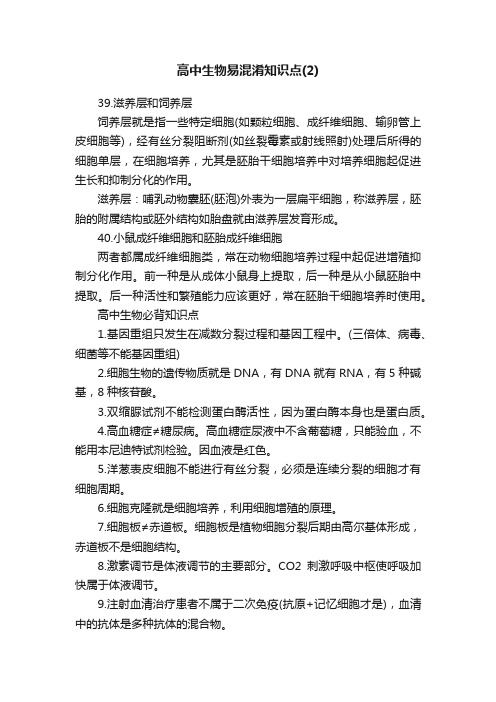
高中生物易混淆知识点(2)39.滋养层和饲养层饲养层就是指一些特定细胞(如颗粒细胞、成纤维细胞、输卵管上皮细胞等),经有丝分裂阻断剂(如丝裂霉素或射线照射)处理后所得的细胞单层,在细胞培养,尤其是胚胎干细胞培养中对培养细胞起促进生长和抑制分化的作用。
滋养层:哺乳动物囊胚(胚泡)外表为一层扁平细胞,称滋养层,胚胎的附属结构或胚外结构如胎盘就由滋养层发育形成。
40.小鼠成纤维细胞和胚胎成纤维细胞两者都属成纤维细胞类,常在动物细胞培养过程中起促进增殖抑制分化作用。
前一种是从成体小鼠身上提取,后一种是从小鼠胚胎中提取。
后一种活性和繁殖能力应该更好,常在胚胎干细胞培养时使用。
高中生物必背知识点1.基因重组只发生在减数分裂过程和基因工程中。
(三倍体、病毒、细菌等不能基因重组)2.细胞生物的遗传物质就是DNA,有DNA就有RNA,有5种碱基,8种核苷酸。
3.双缩脲试剂不能检测蛋白酶活性,因为蛋白酶本身也是蛋白质。
4.高血糖症≠糖尿病。
高血糖症尿液中不含葡萄糖,只能验血,不能用本尼迪特试剂检验。
因血液是红色。
5.洋葱表皮细胞不能进行有丝分裂,必须是连续分裂的细胞才有细胞周期。
6.细胞克隆就是细胞培养,利用细胞增殖的原理。
7.细胞板≠赤道板。
细胞板是植物细胞分裂后期由高尔基体形成,赤道板不是细胞结构。
8.激素调节是体液调节的主要部分。
CO2刺激呼吸中枢使呼吸加快属于体液调节。
9.注射血清治疗患者不属于二次免疫(抗原+记忆细胞才是),血清中的抗体是多种抗体的混合物。
10.刺激肌肉会收缩,不属于反射,反射必须经过完整的反射弧,判断兴奋传导方向有突触或神经节。
11.递质分兴奋性递质和抑制性递质,抑制性递质能引起下一个神经元电位变化,但电性不变,所以不会引起效应器反应。
12.DNA是主要的遗传物质中“主要”如何理解?每种生物只有一种遗传物质,细胞生物就是DNA,RNA也不是次要的遗传物质,而是针对“整个”生物界而言的。
只有少数RNA病毒的遗传物质是RNA。
2019高考-高中生物第三章生物科学与降第三节生殖降课后自我小测浙科版选修

第三节生殖健康自我小测1世界试管婴儿之父是( )A.卡尔文 B.鲁宾和卡门C.斯特普顿 D.达尔文2如果妻子的生育能力正常,但因丈夫产生的精子少或精子活力差而造成的不育,一般采用的辅助生殖技术是( )A.人工授精 B.体外受精(试管婴儿)C.细胞克隆 D.人体克隆3如果丈夫的生殖能力正常,但妻子因输卵管阻塞而不孕,可采用的辅助生殖技术是( )A.人工授精 B.体外受精(试管婴儿)C.细胞克隆 D.人体克隆4我国内地首例试管婴儿诞生于( )A.1989年 B.1988年C.1990年 D.1978年5试管婴儿实质就是“体外受精”和“胚胎移植”的产物,其中“胚胎移植”的是( ) A.受精卵 B.8~16个细胞的囊胚C.原肠胚 D.器官形成6下列哪种情况可实施供精人工授精( )①男方精液正常,不能完成生殖过程②男方有遗传病③免疫性不孕④近亲结婚者⑤女性宫颈畸形,精液不能进入生殖道内A.①⑤ B.②③④C.①③④ D.①②③④⑤7试管婴儿、试管苗和克隆羊三者均属于生物工程技术的杰出成果,下面叙述正确的是( )A.都属于无性生殖能保持母本性状B.都是细胞工程的技术范围C.都充分体现了体细胞的全能性D.都不会发生基因重组和变异8以下关于试管婴儿技术不存在的是( )A.体外受精 B.细胞培养C.胚胎移植 D.基因重组9“试管婴儿”技术是解决不孕症的有效手段,1978年世界上诞生了第一例“试管婴儿”。
这项技术实际上是指受精卵在体外培养2~3 d,形成胚胎后移植回母体子宫后继续发育形成胎儿直至分娩。
请判断“试管婴儿”技术在生物上依据的原理是( ) A.有性生殖 B.无性生殖C.克隆技术 D.基因工程10精子和卵子在体外受精后,应将受精卵移入…( )A.受体动物体内 B.培养箱C.发育培养液 D.冷库冷藏11艾滋病(AIDS)是目前威胁人类生命的重要疾病之一。
请回答:(1)如果将病毒置于细胞外,该病毒不能繁殖,原因是________________________________________________________________________。
高考生物一轮复习 第十一单元 现代生物科技专题 专题31 胚胎工程与生态工程 考点1 胚胎工程课件

3.下列有关哺乳动物精子和卵细胞的发生及受精作用的叙述,正确的是( ) A.采集到的精子和卵细胞相遇即可发生受精作用 B.卵子发生时 MⅠ和 MⅡ是不连续的,不需要变形,但细胞质均等分配 C.卵细胞形成时的分裂过程均在卵巢内完成 D.受精作用完成时的标志是雌雄原核结合成为合子
3 胚胎工程的应用和前景 (1)胚胎移植 ①胚胎来源:转基因、核移植、体外受精、体内受精。 ②实质:产生胚胎的 供体 和孕育胚胎的 受体 共同繁育后代的过程。 ③地位:胚胎移植是胚胎工程中最后一道程序,移植的胚胎必须在原肠胚之前,不能直接移植受精卵。 ④意义:充分发挥 雌性优良个体的繁殖潜能 。 (2)胚胎分割 ①概念:采用机械方法将早期胚胎分割成 2 等份、4 等份或 8 等份等,经移植获得同卵双胎或多胎的 技术。 ②材料:发育良好、形态正常的 桑椹胚或囊胚 。 ③注意事项: 将内细胞团均等分割 。 ④意义:加快繁殖速度,是动物无性繁殖或克隆的方法之一,其他克隆方法还有核移植。
(1)滋养层:囊胚时期沿透明带内壁排列的个体较小的细胞,滋养层最终发育成胎膜和胎盘。 (2)饲养层:饲养层细胞一般为输卵管上皮细胞,在干细胞培养时,可作为提供干细胞分裂、增殖的营 养细胞。
2 试管动物与克隆动物的比较
比较项目
试管动物
技术基础
体外受精、胚胎移植
实例
试管牛
克隆动物 核移植技术、细胞培养、胚胎(分割) 移植
(2)胚胎移植的优势:充分发挥雌性优良个体的繁殖潜力,从而大大缩短了供体本身的繁殖周期,大大 推动了畜牧业的发展。
八年级生物下册第七单元期末温习一第七单元第一章新版新人教版

期末温习(一)(第七单元第一章)知识点一:植物的生殖1.有性生殖和无性生殖的区别和联系比较项目无性生殖有性生殖有无两性生殖细胞的结合无有新个体的产生母体直接产生受精卵发育成新个体繁殖速度快慢后代的适应性弱强实例苹果嫁接、葡萄扦插等大豆、花生的种子繁殖等相同点都能产生新个体,繁殖后代使种族得以延续和发展2.扦插剪取植物的一段枝条,将其下部插入湿润的土壤中,在适宜的温度下,一段时刻后,枝条下部生出不定根,上部发芽,从而发育成一个新个体。
3.嫁接(1)概念:把一个植物体的芽或枝,接在另一个植物体上,使结合在一路的两部份长成一个完整的植物体。
(2)方式:有枝接和芽接两种。
其中接上去的芽或枝叫做接穗;被接的叫做砧木。
(3)关键:嫁接时应当使接穗与砧木的形成层紧密结合,以确保接穗成活。
4.植物的组织培育植物的组织培育是利用无性生殖原理,使植物组织或细胞等快速发育成新植株的生物技术。
知识点二:昆虫的生殖和发育发育时期发育特点相同点完全变态发育卵、幼虫、蛹、成虫幼虫与成虫的形态结构和生活习性差异很大有性生殖、变态发育不完全变态发育卵、若虫、成虫若虫与成虫的形态结构和生活习性相似知识点三:两栖动物的生殖和发育1.生殖特点: 有性(填“有性”或“无性”)生殖, 体外(填“体内”或“体外”)受精、卵生(填“卵生”或“胎生”)。
2.青蛙发育进程:通过受精卵、蝌蚪、幼蛙、成蛙四个时期,且幼体与成体在形态结构和生活习性上具有较大不同,属于变态发育。
3.两栖动物的生殖发育与环境条件:两栖动物的生殖和幼体发育必需在水中进行,幼体要通过变态发育才能上陆地生活。
知识点四:鸟的生殖和发育1.鸟卵各结构的功能(1)爱惜结构{卵壳卵壳膜卵白}保护鸟卵的内部结构系带:固定卵黄(2)呼吸结构{卵壳:有无数肉眼看不到的小孔,是与外界进行气体交换的通道气室:为胚胎发育提供氧气(3)营养结构卵白:为胚胎发育提供水分和养料。
卵黄:为胚胎发育提供营养的主要结构。
八年级生物下册第七单元知识点
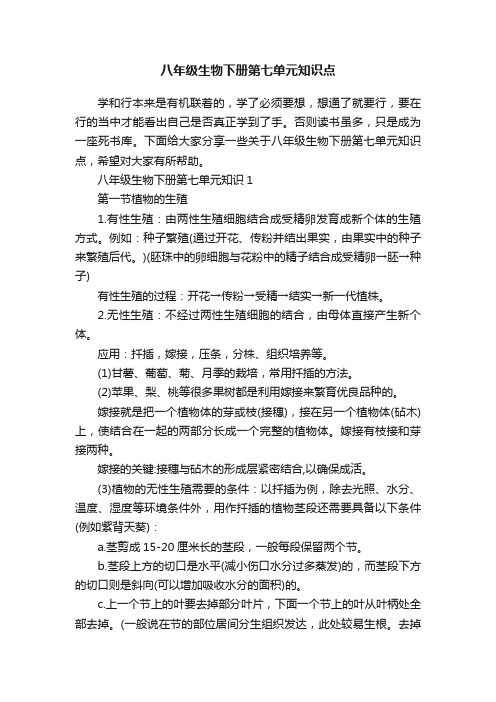
八年级生物下册第七单元知识点学和行本来是有机联着的,学了必须要想,想通了就要行,要在行的当中才能看出自己是否真正学到了手。
否则读书虽多,只是成为一座死书库。
下面给大家分享一些关于八年级生物下册第七单元知识点,希望对大家有所帮助。
八年级生物下册第七单元知识1第一节植物的生殖1.有性生殖:由两性生殖细胞结合成受精卵发育成新个体的生殖方式。
例如:种子繁殖(通过开花、传粉并结出果实,由果实中的种子来繁殖后代。
)(胚珠中的卵细胞与花粉中的精子结合成受精卵→胚→种子)有性生殖的过程:开花→传粉→受精→结实→新一代植株。
2.无性生殖:不经过两性生殖细胞的结合,由母体直接产生新个体。
应用:扦插,嫁接,压条,分株、组织培养等。
(1)甘薯、葡萄、菊、月季的栽培,常用扦插的方法。
(2)苹果、梨、桃等很多果树都是利用嫁接来繁育优良品种的。
嫁接就是把一个植物体的芽或枝(接穗),接在另一个植物体(砧木)上,使结合在一起的两部分长成一个完整的植物体。
嫁接有枝接和芽接两种。
嫁接的关键:接穗与砧木的形成层紧密结合,以确保成活。
(3)植物的无性生殖需要的条件:以扦插为例,除去光照、水分、温度、湿度等环境条件外,用作扦插的植物茎段还需要具备以下条件(例如紫背天葵):a.茎剪成15-20厘米长的茎段,一般每段保留两个节。
b.茎段上方的切口是水平(减小伤口水分过多蒸发)的,而茎段下方的切口则是斜向(可以增加吸收水分的面积)的。
c.上一个节上的叶要去掉部分叶片,下面一个节上的叶从叶柄处全部去掉。
(一般说在节的部位居间分生组织发达,此处较易生根。
去掉叶片时,叶柄在节上留下伤痕,伤口处较容易产生愈伤组织,也就容易生根。
)(4)将马铃薯的块茎切成小块来种植时,每一小块都要带一个芽眼。
第二节昆虫的生殖和发育1.变态发育:在由受精卵发育成新个体的过程中,家蚕的幼虫与成体的形态结构和生活习性差异很大,这种发育过程称为变态发育。
(1)完全变态:同家蚕一样,蜜蜂、菜粉蝶、蝇、蚊、蛾等昆虫的发育也要经过卵、幼虫、蛹、成虫四个时期,这样的发育过程称为完全变态。
2018高中生物 专题3过关检测(含解析)新人教版选修3
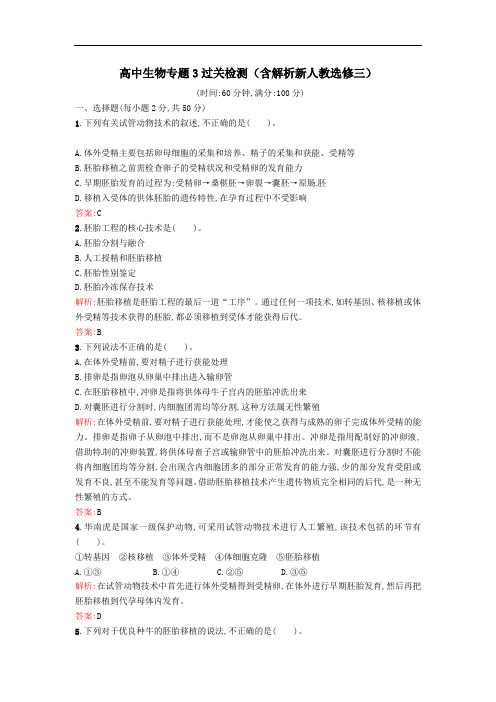
高中生物专题3过关检测(含解析新人教选修三)(时间:60分钟,满分:100分)一、选择题(每小题2分,共50分)1.下列有关试管动物技术的叙述,不正确的是( )。
A.体外受精主要包括卵母细胞的采集和培养、精子的采集和获能、受精等B.胚胎移植之前需检查卵子的受精状况和受精卵的发育能力C.早期胚胎发育的过程为:受精卵→桑椹胚→卵裂→囊胚→原肠胚D.移植入受体的供体胚胎的遗传特性,在孕育过程中不受影响答案:C2.胚胎工程的核心技术是( )。
A.胚胎分割与融合B.人工授精和胚胎移植C.胚胎性别鉴定D.胚胎冷冻保存技术解析:胚胎移植是胚胎工程的最后一道“工序”。
通过任何一项技术,如转基因、核移植或体外受精等技术获得的胚胎,都必须移植到受体才能获得后代。
答案:B3.下列说法不正确的是( )。
A.在体外受精前,要对精子进行获能处理B.排卵是指卵泡从卵巢中排出进入输卵管C.在胚胎移植中,冲卵是指将供体母牛子宫内的胚胎冲洗出来D.对囊胚进行分割时,内细胞团需均等分割,这种方法属无性繁殖解析:在体外受精前,要对精子进行获能处理,才能使之获得与成熟的卵子完成体外受精的能力。
排卵是指卵子从卵泡中排出,而不是卵泡从卵巢中排出。
冲卵是指用配制好的冲卵液,借助特制的冲卵装置,将供体母畜子宫或输卵管中的胚胎冲洗出来。
对囊胚进行分割时不能将内细胞团均等分割,会出现含内细胞团多的部分正常发育的能力强,少的部分发育受阻或发育不良,甚至不能发育等问题。
借助胚胎移植技术产生遗传物质完全相同的后代,是一种无性繁殖的方式。
答案:B4.华南虎是国家一级保护动物,可采用试管动物技术进行人工繁殖,该技术包括的环节有( )。
①转基因②核移植③体外受精④体细胞克隆⑤胚胎移植A.①③B.①④C.②⑤D.③⑤解析:在试管动物技术中首先进行体外受精得到受精卵,在体外进行早期胚胎发育,然后再把胚胎移植到代孕母体内发育。
答案:D5.下列对于优良种牛的胚胎移植的说法,不正确的是( )。
人教版2023初中生物八年级下册第七单元生物圈中生命的延续和发展知识点总结(超全)
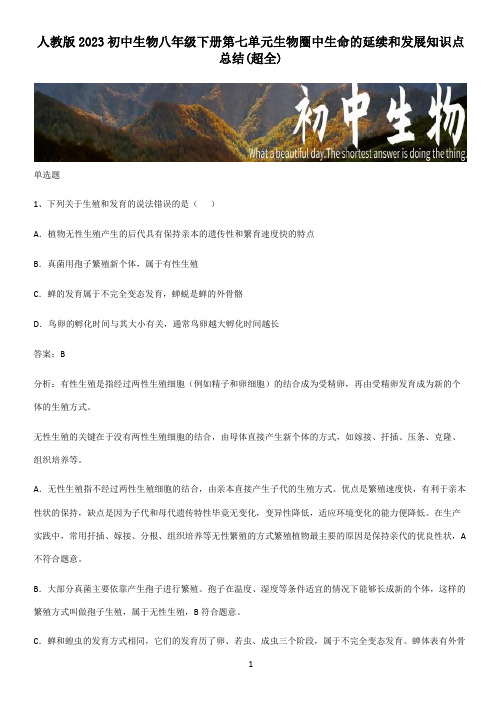
人教版2023初中生物八年级下册第七单元生物圈中生命的延续和发展知识点总结(超全)单选题1、下列关于生殖和发育的说法错误的是()A.植物无性生殖产生的后代具有保持亲本的遗传性和繁育速度快的特点B.真菌用孢子繁殖新个体,属于有性生殖C.蝉的发育属于不完全变态发育,蝉蜕是蝉的外骨骼D.鸟卵的孵化时间与其大小有关,通常鸟卵越大孵化时间越长答案:B分析:有性生殖是指经过两性生殖细胞(例如精子和卵细胞)的结合成为受精卵,再由受精卵发育成为新的个体的生殖方式。
无性生殖的关键在于没有两性生殖细胞的结合,由母体直接产生新个体的方式,如嫁接、扦插、压条、克隆、组织培养等。
A.无性生殖指不经过两性生殖细胞的结合,由亲本直接产生子代的生殖方式。
优点是繁殖速度快,有利于亲本性状的保持,缺点是因为子代和母代遗传特性毕竟无变化,变异性降低,适应环境变化的能力便降低。
在生产实践中,常用扦插、嫁接、分根、组织培养等无性繁殖的方式繁殖植物最主要的原因是保持亲代的优良性状,A 不符合题意。
B.大部分真菌主要依靠产生孢子进行繁殖。
孢子在温度、湿度等条件适宜的情况下能够长成新的个体,这样的繁殖方式叫做孢子生殖,属于无性生殖,B符合题意。
C.蝉和蝗虫的发育方式相同,它们的发育历了卵、若虫、成虫三个阶段,属于不完全变态发育。
蝉体表有外骨骼,发育过程中外骨骼不能随着身体的生长而生长,因此有蜕皮现象,蝉蜕是蝉的外骨骼,C不符合题意。
D.“二十一天的鸡、二十八天的鸭、一个月小鹅才出壳”,从中可以看出:一般来说,鸟的体型的越大,产生的鸟卵越大,其孵化时间越长;鸟的体型越小,产生的鸟卵越小,孵化期越短,D不符合题意。
故选B。
2、学习了“植物的生殖”后,小强在家进行了如下操作。
该繁殖方式是A.扦插B.嫁接C.杂交D.植物的组织培养答案:B分析:嫁接是指把一个植物体的芽或枝,接在另一个植物体上,使结合在一起的两部分长成一个完整的植物体。
嫁接时,接上去的部分为接穗,被接的植物是砧木。
- 1、下载文档前请自行甄别文档内容的完整性,平台不提供额外的编辑、内容补充、找答案等附加服务。
- 2、"仅部分预览"的文档,不可在线预览部分如存在完整性等问题,可反馈申请退款(可完整预览的文档不适用该条件!)。
- 3、如文档侵犯您的权益,请联系客服反馈,我们会尽快为您处理(人工客服工作时间:9:00-18:30)。
以STO细胞和hELF作为胚胎生殖细胞培养饲养层的比较作者:刘永刚,李芳菲,陈地龙,王莎莉,王亚平【关键词】 STO细胞;胚胎肺成纤维细胞;胚胎生殖细胞;人类Comparison between STO cells and hELF used as feeder layers of embryonic germ cells【Abstract】 AIM: To compare the influence on the growth of human embryonic germ (EG) cells by SIM mouse embryoderived thioguanine and ouabain resistant (STO) cells and human embryonic lung fibroblasts(hELF)respectively as feeder layers and the changes of the two kinds of the feeder layers themselves processed with mitomycin C. METHODS: We isolated and cultured hELF of 3-4 month embryos. The changes of the two kinds of the feeder layers themselves treated with mitomycin C were observed. STO and hELFs erved as feeder layer to cultivate human EG cells.The formation rate of embryonic germ cell colony and the expression of EG cell surface markers(SSEA1, SSEA4) expression were detected. to discuss the influence on human EG cell growth. RESULTS: HELF treated by mitomycin C survived longer than STO cells treated by mitomycin C did. There was no obvious difference between the two kinds of feeder layers in the formation rate and immunologic markers (SSEA1, SSEA4) of EG cell colony. CONCLUSION:HELF as feeder layers is better than STO cells in culturing EG cells.【Keywords】 STO cells; embryonic lung fibroblasts; embryonic germ cells; humans【摘要】目的:比较以STO细胞和人胚胎肺成纤维细胞(hELF)作为饲养层对人胚胎生殖嵴细胞(EG)生长的影响以及经丝裂酶素C处理后的两种饲养层的变化. 方法:分离、培养3~4 mo hELF,观察经丝裂酶素C处理STO细胞和hELF后形态学变化,以STO细胞和hELF 作为饲养层培养人EG细胞,计数EG细胞集落的形成率以及免疫组化检测EG细胞表面标志物抗阶段特异性胚胎抗原1(SSEA1)和抗阶段特异性胚胎抗原4(SSEA4). 结果:经丝裂霉素C处理后hELF较STO细胞生存时间明显长,形态维持更好;以hELF和STO细胞作为饲养层培养人EG细胞,集落形成率没有明显差异;两种饲养层上形成的集落免疫学特征无明显差异. 结论:在培养人EG细胞时,hELF饲养层较STO 细胞饲养层更有优势.【关键词】 STO细胞;胚胎肺成纤维细胞;胚胎生殖细胞;人类0引言自1998年Thomason等[1]首次建立人胚胎干细胞(embryonic stem cell, ES)系和Shamblott等[2]建立人胚胎生殖细胞(embryonic germ cell, EG)系以来,胚胎性干细胞研究已成为当今生命科学领域内的热门课题. 胚胎性干细胞作为组织工程的种子细胞,将为细胞、组织甚至器官替代治疗提供无限细胞来源,也将为临床治疗模式带来革命性变革[3]. 谢松涛等[4]也对人胚胎生殖嵴来源的人EG细胞进行了培养,但迄今为止,来源于人胚胎生殖嵴的EG细胞系仅有一例报道. 有学者认为STO细胞在建立人EG细胞系过程中具有不可替代的作用. 由于STO 细胞是来源于鼠的成纤维细胞系,用STO细胞作为饲养层将会给临床应用带来潜在的危险. 我们用STO细胞和人胚胎肺成纤维细胞(human embryonic lung fibroblast, hELF)作为饲养层培养人EG细胞,旨在探讨两种饲养层经丝裂酶素C处理后的变化和对EG细胞生长的影响.1材料和方法1.1材料高糖DMEM培养基(Dulbeccos modified Eagles medium, DMEM)购自GIBICO公司;无钙镁磷酸缓冲液 (Dulbeccos phosphate buffered saline, DPBS)、非必需氨基酸、二甲基亚砜、优质胎牛血清购自Hyclone公司;胰蛋白酶、β巯基乙醇、毛喉素(Forskolin)购自Sigma公司;丝裂霉素C 购自Kyowa Hakko Kogyo 公司;胶原酶购自上海桥源生物制药公司; DNA酶Ⅰ购自Roche公司;人重组碱性成纤维细胞生长因子(human recombinant basic fibroblast growth factor, hrbFGF) 购自Pepro Tech EC公司;人重组白血病抑制因子(human recombinant leukemia inhibitory factor, hrLIF)购自CHEMICON公司;抗阶段特异性胚胎抗原1(SSEA1)mAb和抗阶段特异性胚胎抗原4(SSEA4)mAb由美国芝加哥大学Dr. Bruce Lahn提供;UltrasenstinveTM SP试剂盒购自迈新公司;DAB显色试剂盒购自中山公司;6~11 wk人工流产胚胎(重庆医科大学第二临床学院人流室同意提供)用于分离人EG细胞;3~4 mo胚胎用于制备hELF;STO细胞由本室保存.1.2方法mo人工流产胚胎肺组织,按照薛庆善等的方法分离获取hELF,常规方法培养传代,经反复传代获得纯化的hELF. 取对数生长期hELF,用终浓度为12.5 μg/mL丝裂霉素C处理2.5~3 h;DPBS 洗3次; 2.5 g/L胰酶消化2 min;DPBS洗3次;以细胞浓度为2×105/mL种植在1 g/L明胶处理后的24孔培养板中,每孔1 mL;置37℃,95%湿度和50 mL/L CO2恒温细胞培养箱中培养,4 h后吸去培养液和尚未贴壁的细胞,换入等量培养液,置培养箱中备用,1 wk内均可使用.,用终浓度为10 μg/mL丝裂霉素C按上述方法处理备用.wk胚胎生殖嵴用DPBS冲洗3次;400 U/mL的胶原酶0.5 mL, 37℃下消化45 min;灭菌加样枪反复吹吸,将生殖嵴离散为小细胞团;1 g/L的胰蛋白酶和0.2 g/L EDTA溶液,37℃下消化5 min;加入等体积含100 mL/L胎牛血清的培养液终止反应;加入200 U的DnaseⅠ作用10 min;轻柔吹打使细胞分离,胚胎干细胞培养液重悬后以1×105, 1×10, 1×103/mL三种浓度种植于STO细胞和hELF细胞饲养层,胚胎干细胞培养液包含800 mL/L高糖DMEM, 200 mL/L胎牛血清,2 mmol/L L谷胺酰氨,0.1 mmol/L非必需氨基酸,0.1 mmol/L 2巯基乙醇,10 μmol/L Forskolin, 2 μg/mL hrbFGF, LIF 10×105 IU/L, 10×104 IU/L青霉素和10×104 IU/L链霉素. 置50 mL/L CO2, 95%湿度,37℃恒温细胞培养箱中培养,每天更换培养基.d,在倒置相差显微镜下观察两种饲养层细胞的形态变化. 倒置相差显微镜下观察在STO细胞饲养层和hELF饲养层上人EG细胞集落形态., 1×104, 1×103/mL的细胞悬液,分别种植于STO细胞和hELF饲养层上,每种细胞浓度种植4个复孔. 置于37℃, 50 mL/L CO2饱和湿度恒温细胞培养箱中培养,每天更换培养基. 计算集落形成率,即4个复孔形成集落总数与种植细胞总数之比.,40 g/L多聚甲醛固定15~20 min;经PBS洗3次;按免疫组化SABC法检测细胞表面抗原SSEA1和SSEA4(一抗工作浓度为1∶50). 设不加一抗组为阴性对照组.统计学处理:数据以x±s表示,采用SPSS12.0进行方差分析F检验. 显著性水平α=0.05, P<0.05为有显著性差异.2结果2.1hELF体外生长与传代原代培养时所得细胞,细胞形状多种多样. 传代细胞至第3~5代时细胞形态基本一致,以长梭形成纤维样细胞为主,细胞排列成为放射状、漩涡状或栅栏状(图 1A). 将其反复传至第45代,在第5~30代时生长最旺盛,平均3~4 d达到汇合;第31~45代时平均5~6 d达到汇合,形态无显著变化.2.2丝裂霉素C处理后STO细胞和hELF形态变化用人ES生长培养液培养STO细胞和hELF饲养层,培养48 h观察,STO细胞的培养液变黄,而人hELF的培养液颜色没有明显改变. 不更换培养液,培养72 h后,少部分STO细胞浮起,细胞内可见颗粒状物形成;培养超过6 d,大部分细胞浮起. 每3 d更换一次培养液,STO细胞培养5 d后有部分细胞浮起,细胞内出现颗粒状物(图 1B). 而人hELF,培养7 d未见细胞浮起,细胞形态未见明显改变,并可维持14 d(图 1C).2.3两种饲养层细胞对胚胎生殖细胞集落形成的影响人胚胎生殖嵴细胞以1×105,1×104,1×103/mL三种浓度种植于STO细胞和hELF饲养层上,培养7 d后观察计数. 结果显示:以1×104/mL 组,集落形成最多,集落形态典型 (图2A,B);1×103/mL组,集落形成数量最少;1×105/mL组,可见较多集落分化,集落细胞质中有颗粒样物出现,饲养层细胞和胚胎生殖细胞容易卷折. 以相同浓度种植胚胎生殖嵴细胞,两种饲养层细胞对人EG细胞集落形成率没有显著性差异.A: 丝裂霉素C处理前hELF; B: 丝裂霉素C处理STO细胞后培养7 d;C: 丝裂霉素C处理hELF后培养7 d.图1丝裂霉素C处理前后hELF和STO细胞×400(略)A: hELF饲养层上EG细胞集落;B: STO细胞饲养层上EG细胞集落.图2STO细胞和hELF饲养层上的EG细胞集落×400(略)2.4人胚胎生殖细胞集落免疫学特征经检测集落表面抗原SSEA1和SSEA4,显示两种饲养层细胞上培养的人胚胎生殖细胞集落均表达SSEA1和SSEA4(图3A,B).A: hELF饲养层上表达SSEA1集落;B: STO细胞饲养层上表达SSEA4集落.图3胚胎生殖细胞集落表达SSEA1和SSEA4×400(略)3讨论饲养层是建立和维持人胚胎性干细胞系未分化状态的必要条件. 迄今为止,己分离得到的非人灵长类和人胚胎性干细胞系无一不是在有饲养层条件下建立和维持的,在无饲养层的情况下,人ES, EG 细胞毫无例外地分化为多种细胞类型. 目前已建立的人胚胎性干细胞系都以鼠源性胚胎成纤维细胞为饲养层[5]. 有报道称用人源性饲养层,如人胚胎皮肤和肌肉细胞、输卵管细胞和人骨髓基质细胞,也能维持人ES细胞体外增殖和保持其未分化状态,由于上述饲养层存在来源、体外增殖能力低等问题而在应用中受限[6-8]. 而在仅有的一例关于人EG细胞系的建系报道中,用MEF作为饲养层却是不成功的,因而有学者认为ST0细胞饲养层在人EG细胞建系中具有不可替代的作用. 这―结论是很难解释的,因为仅有一例报道,尚不能确定其他饲养层在人EG细胞建系中的确切作用,尤其是人胚胎成纤维细胞饲养层.我们的研究结果显示: 1×104/mL接种的生殖嵴细胞在两种饲养层上形成的人EG集落最多,且经过对集落的表面标志物SSEA1和SSEA4的检测证实所形成的集落为人EG细胞集落. 但是以STO细胞作为饲养层和以hELF作为饲养层之间对EG集落形成率并无显著性差异. 提示两种饲养层都能较好支持人EG细胞的生长和克隆的形成. 以1×105/mL和1×103/mL接种的生殖嵴细胞形成的EG集落数量较少,而两种饲养层之间EG集落形成率没有显著性差异,提示以1×105/mL浓度种植的胚胎生殖嵴细胞浓度大,细胞生长过快,尤其是胚胎生殖嵴中的其它细胞生长快,容易和饲养层细胞一起卷折,不利于胚胎生殖细胞集落的形成. 还由于胚胎生殖细胞集落培养体系的营养供给不足,造成部分集落分化. 而种植浓度太低,也不利于集落的形成. 因此以1×104/mL作为最佳的种植浓度,且最有利集落的形成.以STO细胞和hELF细胞作为饲养层分离、培养人EG细胞,hELF饲养层有以下优点:① hELF与人EG细胞相同种属,不会引入异种蛋白和动物源性病原微生物,更有利今后临床应用;②经过丝裂霉素C处理后,能在体外培养达14 d依然维持较好的生长状态. ③hELF能体外连续传代50代以上,较鼠胚胎成纤维细胞、成人骨髓基质细胞等明显长,且经过多次传代后细胞均一,同质性高,有利于对其培养体系的精确分析. 不足的是,迄今为止,没有利用hELF细胞饲养层建立人EG细胞系的报道.【参考文献】[1] Thomson JA, ItskovitzEldor J, Shapiro SS, et al. Embryonic stem cell lines derived from human blastocysts [J]. Science, 1998,282:1145-1147.[2] Shamblott MJ, Axelman J, Wang S, et al. Derivation of pluripotent stem cells from cultured human primordial germ cells [J]. Proc Natl Acad Sci USA, 1998,95:13726-13731.[3] Pera MF, Reubinoff BF, Trounson A, et al. Humanembryonic stem cells [J]. Cell Sci, 2000,113:5-10.[4]谢松涛,朱德生,杨贵忠,等. 人胚胎原生殖细胞中胚胎干细胞的分离培养[J].第四军医大学学报,2003,24(10)905-907.[5] Thomson JA, Odorico JS. Human embryonic stem cell and embryonic germ cell lines[J]. Trends Biotechol, 2000,18:53-57.[6] Richards M, Tan S, Fong CY, et al. Comparative evaluation of various human feeders for prolonged undifferentiated growth of human embryonic stem cells[J]. Stem Cells, 2003,21(5):546-556.[7] Richards M, Fong CY, Chan WK, et al. Human feeders support prolonged undifferentiated growth of human inner cell masses and embryonic stem cells [J]. Nat Biotechnol, 2002,20(9):933-936.[8] Cheng L, Hammond H, Ye Z, et al. Human adult marrow cells support prolonged expansion of human embryonic stem cells in culture[J]. Stem Cells, 2003,21(2):131-142.。
